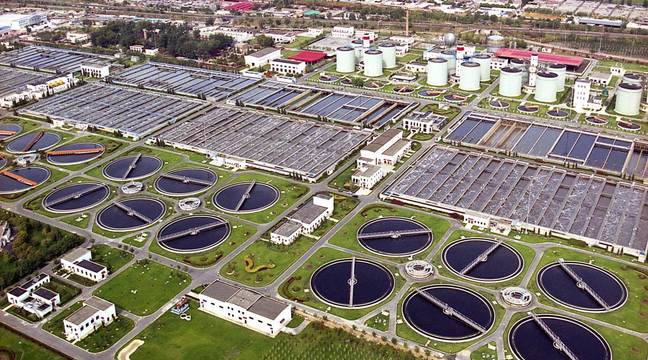
当前课程知识点:Water and Wastewater Treatment Engineering: Biochemical Technology > Chapter 8 Sludge Treatment and Disposal Process > Section 8.3 Sludge conditioning, dehydration and incineration > Section 8.3 Sludge conditioning, dehydration and incineration
返回《Water and Wastewater Treatment Engineering: Biochemical Technology》慕课在线视频课程列表
返回《Water and Wastewater Treatment Engineering: Biochemical Technology》慕课在线视频列表
好,同学们好,我们来学习第三节,污泥的调理、脱水以及干化焚烧
首先我们来介绍污泥的调理,通常我们采用加药调理法
实际上是在污泥中间加入一定量的带有电荷的无机的或者是有机的化学药剂
当然这种药剂,我们通常称为调理剂
使污泥的液体以及固体颗粒的表面发生一定的化学反应
对颗粒表面的电荷进行中和,使水游离出来
同时使污泥中间的颗粒发生凝聚,生成更大的颗粒的絮体
降低污泥的比阻抗,或者是它的CST,也就是污泥毛细管吸水时间
调理结果的好坏,跟调理剂的种类、投加量以及环境因素
特别是温度等直接相关,常采用的调理剂
我们分为无机的调理剂、有机的调理剂
无机的调理剂实际上主要是一些无机的盐类,像通常采用的是铁盐,或者是铝盐
这里列出了各种形式的铁盐和铝盐
通常在一定的条件下,还会将铁盐跟石灰联用,可以获得更好的效果
常采用的有机的调理剂,我们是阳离子型的聚丙烯酰胺
通常用于带式的压滤机
关于调理剂的投加量的确定,我们通常需要通过小型试验来进行确定
我们对一个污泥的样品,通过投加不同量的调理剂
最后通过测量它的脱水性能的指标
好比说是污泥比阻抗,或者说是CST
找到最佳点,这两条曲线中间的最低点,我们通常认为是最佳的投加量的点
因此,我们就可以通过实验获得最佳的调理剂的投加量
调理效果的影响因素,跟污泥的性质,调理剂的种类和投加量
环境条件,像污泥的水温、污泥的pH值,以及调理剂的投加的次序
以及污泥跟调理剂的混合的程度,都会有关
调理之后,我们就需要对污泥进行脱水或者说干化
污泥脱水和干化主要的目的,是去除污泥中间大量的水分
缩小湿污泥的体积,减轻湿污泥的重量,对后续的处理减轻负担
经过脱水后的干化处理以后
污泥的含水量一般能从90%下降到60%-80%
它的体积可以下降为原来的十分之一到五分之一
自然干化,我们通常采用这种干化床
实际上真正的脱水,我们在大型厂里面通常会采用机械脱水
机械脱水有板框压滤机,带式压滤机和离心脱水机等
我们先来看一下干化床,也就是所谓的自然干化
实际上是通过污泥投放到一个干化床上
通过自然的蒸发,和自然的渗透,使污泥中间的水分得到降低
含水率通常可以达到65%,通常只是适用于中小型的污水处理厂
这里给出的是一个自然干化床的一个平面图和一个立面图
可以看到实际上是在污泥的平铺在一个带有渗透性能较好的下贴面的这样一个干化床上
在上部要防止降雨
最近在国内外,有一种先进的自然干化床
实际上是在这样一个干化床的上部,增加一个玻璃栏防
利用太阳光,提高污泥的蒸发,加快污泥水分的脱除
最常采用的,实际上还是机械脱水,特别是在一些发达国家
经过脱水以后的污泥,占到总量的70%以上,机械脱水占到50%以上
主要的脱水机械,有离心机、板框压滤机、带式压滤机以及、真空过滤机
好,我们谈到机械过滤,第一种是真空过滤机
第二种是板框压滤机,是最早应用于污泥脱水的机械
它的特点是间歇操作,基建费用比较大,过滤的能力稍微有点低
但是它滤饼的含固率,可以达到比较高的水平
而且过滤以后的上清液比较清,药剂的用量需要的比较少
这张图给出的是一个板框压滤机的一个工作示意图
我们可以看到,实际上是由一系列的板和框加上滤布形成一个过滤系统
通过高压泵,将污泥打入这样的一个系统中间
这张图的给出了它的一个基本的工作原理图
我们可以看到,通过高压泵打入的污泥
进入板框之间,这样的一个空腔
通过滤布的隔离将上清液从底部排出
而剩余的污泥,在滤料的表面形成泥饼
这样实现了一个污泥的脱水
这张图会稍微的更清楚的表现出板框和滤布
它们之间的关系,是这样的一个关系,通过高压泵进入以后的污泥,会受到挤压
水通过滤布,从底部排出,而污泥在滤料的表面形成泥饼
这张图,也给出的是一个板框压滤的一个全景图
可以看到,由高压泵和板框以及框架,来构成的一个整体的板框压滤机
第三种机械脱水机,我们称为带式压滤机
带式压滤机跟板框压滤机最大的不同是,它可以连续的工作
这个是在当时运用这种合成有机的聚合物的调理剂发展以后
通过投加有机的絮凝剂,能够改善脱水性能
就可以使得带式压滤机能够连续的工作
它的操作管理相对简单,附属的设备也较少
但是它需要投加的絮凝剂的量比较多,而且导致的费用会比较贵
使得它的运行费用会较高,这张图
实际上给出了带式压滤机的一个基本的工作原理图
可以看到,一个带式压滤机,通常至少有两条带,或者三条带来组成
在这个图上给出的是三条带的一个板框压滤机
第一条带,独立形成简单的形成污泥的浓缩段
第二条和第三条带,将浓缩以后的污泥,夹在这两条带之间
通过滚珠之间的挤压,使脱水达到比较高的水平
最终泥饼,从两条带之间排出
而上清液,在整个机器中间得以收集
当然带式压力机有各种形式
刚才说过,一般来说至少是两条带,也有三条带
滚珠之间也有不同的运行的形式
这里面给出了几种常用的带式压滤机的基本的结构示意图
这是一个三条带组成的带式压滤机组成的全景图
第四种机械的脱水设备,我们称为离心脱水
通常采用的是污泥的离心机,或者是转筒似的离心机
它利用离心力使污泥中间的固体和水分进行分离
离心力场可以达到重力场的一千倍以上
它的处理能力比较大,基建或占地比较少,操作相对简单,而且自动化的程度非常高
在实际运行中间,可以不投入或者是少量的投加化学调理剂
但是它的动力费用比较高
这里面给出的是离心脱水机的一个工作原理图
我们可以看到,污泥通过一根管道
从中部送入到离心转筒的内部
高速离心以后,形成的泥饼会被甩到转毂的内壁
而上清液可以从中部排出,通过螺旋的推进
可以将在内壁形成的污泥泥饼,可以外排出离心机
这给出了一些正在工作的离心脱水机的示意图
第三点是关于污泥的干化与焚烧
污泥的干化是将脱水污泥通过进一步的处理
使污泥中间的毛细水、吸附水以及部分内部水得到大部分的去除的方法
它可以使污泥的含水率从60%-80%降低到10%-30%左右
而污泥的焚烧,是将干燥后的污泥通过焚烧的办法将污泥中间的吸附水和内部水
以及有机物的全部的去除,使含水率基本降低到零,污泥变成灰尘
干燥与焚烧,是非常可靠和有效的污泥处理方法
但是它的设备投资和运行费用都很昂贵
在国内的干化和焚烧,已经得到越来越多的应用
好,这张图给出的是污泥流化床的焚烧系统
可以看出,它的主体是流化床的焚烧器
随后有锅炉利用预热来进行发电,还有后续的烟气的处理系统
这样的一套系统,如果能够对烟气进行妥善的处理
是一个非常有效的,非常高效的处理系统
不仅可以把污泥缩减到最小的体积,而且还能够充分的利用污泥中间的有机物进行余热发电
好,这一部分的内容就到这,谢谢大家
-Section 0.1 Development Status of Wastewater Treatment Process
--Section 0.1 Development Status of Wastewater Treatment Process
-Section 0.2 Typical Processes of Wastewater Biological Treatment
--Section 0.2 Typical Processes of Wastewater Biological Treatment
-Section 1.1 Principles of wastewater aerobic biological treatment
--1.1 Principles of wastewater aerobic biological treatment
-Section 1.2 Principles and determination of wastewater biodegradability
--1.2 Principles and determination of wastewater biodegradability
-Section 1.3 Principles of wastewater anaerobic biological treatment
--Section 1.3.1 Principles of wastewater anaerobic biological treatment(1)
--Section 1.3.2 Principles of wastewater anaerobic biological treatment(2)
-Section 1.4 Principles of wastewater biological nitrogen removal
--Section 1.4 Principles of wastewater biological nitrogen removal
-Section 1.5 Principles of wastewater biological phosphorus removal
--Section 1.5 Principles of wastewater biological phosphorus removal
-Chapter 1 Homework
-Section 2.1 Basic concept of activated sludge process
--Section 2.1.1 Basic concept of activated sludge process
--Section 2.1.2 Basic concept of activated sludge process
-Section 2.2 Growth rule of activated sludge and its application
--Section 2.2 Growth rule of activated sludge and its application
-Section 2.3 Running mode of activated sludge process
--Section 2.3.1 Running mode of activated sludge process(1)
--Section 2.3.2 Running mode of activated sludge process(2)
-Section 2.4 Kinetics of active sludge process
--Section 2.4.1 Kinetics of active sludge process(1)
--Section 2.4.2 Kinetics of active sludge process(2)
--Section 2.4.3 Kinetics of active sludge process(3)
--Research and Development of Kinetic Model of Activated Sludge Process
-Section 2.5 Principle, calculation and equipment of aeration
--Section 2.5.1 Principle, calculation and equipment of aeration(1)
--Section 2.5.2 Principle, calculation and equipment of aeration(2)
-Section 2.6 Designing of activated sludge process
--Section 2.6 Designing of activated sludge process
-Section 2.7 Operation and management of active sludge process
--Section 2.7.1 Operation and management of active sludge process (1)
--Section 2.7.2 Operation and management of active sludge process (2)
-Chapter 2 Homework
-Section 3.1 Basic principle of biofilm
--Section 3.1 Basic principle of biofilm
-Section 3.2 Biofilter process
--Section 3.2.1 Biofilter Process (1)
--Section 3.2.2 Biofilter process (2)
--Section 3.2.3 Biofilter process (3)
-Section 3.3 Biodisk process
-Section 3.4 Biological contact oxidation process
--Section 3.4 Biological contact oxidation process
-Section 3.5 Aerobic biological fluidized bed process
--Section 3.5 Aerobic biological fluidized bed process
-Chapter 3 Homework
-Section 4.1 Oxidation ditch process
--Section 4.1 Oxidation ditch process
-Section 4.2 A-B process
-Section 4.3 SBR process
-Section 4.4 MBR process
-Chapter 4 Homework
-Section 5.1 Overview and characteristics of development of anaerobic biological treatment
--Section 5.1 Overview and characteristics of development of anaerobic biological treatment
-Section 5.2 Anaerobic digester
--Section 5.2 Anaerobic digester
-Section 5.3 Anaerobic contact process and anaerobic filter process
--Section 5.3 Anaerobic contact process and anaerobic filter process
-Section 5.4 UASB process
-Section 5.5 Other anaerobic biological treatment process
--Section 5.5 Other anaerobic biological treatment process
-Section 5.6 Operation management of anaerobic biological treatment process
--Section 5.6 Operation management of anaerobic biological treatment process
-Chapter 5 Homework
-Section 6.1 Introduction
-Section 6.2 Biological nitrogen removal process and technology
--Section 6.2 Biological nitrogen removal process and technology
-Section 6.3 Biological phosphorus removal process and technology
--Section 6.3 Biological phosphorus removal process and technology
-Section 6.4 Simultaneous nitrogen and phosphorus removal process
--Section 6.4 Simultaneous nitrogen and phosphorus removal process
-Chapter 6 Homework
-Section 7 Natural biological treatment process
--Section 7 Natural biological treatment process
-Chapter 7 Homework
-Section 8.1 Source, nature and treatment of sludge
--Section 8.1 Source, nature and treatment of sludge
-Section 8.2 Sludge thickening and digestive stability
--Section 8.2 Sludge thickening and digestive stability
-Section 8.3 Sludge conditioning, dehydration and incineration
--Section 8.3 Sludge conditioning, dehydration and incineration
-Chapter 8 Homework
-Section 9 Wastewater Discharge and Reuse
--Section 9 Wastewater Discharge and Reuse
-Chapter 9 Homework
